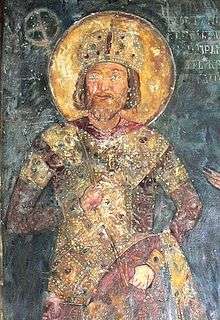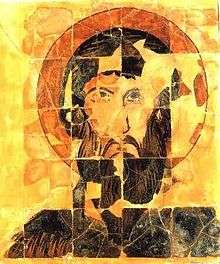Despotate of Dobruja
.svg.png)

The Principality of Karvuna or Despotate of Dobruja (Bulgarian: Добруджанско деспотство or Карвунско деспотство; Romanian: Despotatul Dobrogei or Țara Cărvunei) was a 14th-century quasi-independent polity in the region of modern Dobruja, that split off from the Second Bulgarian Empire under the influence of the Byzantine Empire.
The principality's name is derived from the fortress of Karvuna (present Kavarna), mentioned in Bulgarian and Byzantine documents and Italian portolans of the 14th century as its first capital, and located between Varna and Cape Kaliakra.
History
The principality was spun off from the Second Bulgarian Empire (followed by other frontier regions of Bulgaria such as Vidin and Velbuzhd) around 1340 under Balik (member of the Bulgarian-Cuman dynasty of Terter according to some authors[2]) and placed itself ecclesiastically under the Patriarchate of Constantinople. A "Metropolitan of Varna and Carbona" was mentioned in 1325. Under Balik's son Dobrotitsa (1347–1386; ruling with the title of "despot" after 1357) the principality came to its greatest power and extension and the capital was moved to Kaliakra.
In 1346 or 1347, the principality was plagued by the Black Death, transmitted by Genoese boats from Caffa before they finally brought it to Sicily, Genoa and the whole of Western Europe. The principality had its own navy, which also engaged in piracy forcing the Genoese to complain, and possibly took part in an operation off Trebizond. In 1453, the Ottoman navy at the siege of Constantinople was initially led by one admiral Baltoglu, a Bulgarian convert from the former principality.
In 1366, Ivan Alexander refused to give conduct to the John V Palaiologos who was returning home from Hungary. In order to force the Bulgarians to comply, John V ordered his relative Count Amadeus VI of Savoy to attack the Bulgarian coastal towns. In the fall of the same year, Amadeus' navy took Pomorie, Nessebar, Emona, and Kozyak, and on 25 October besieged the strong fortress of Varna, where it was repulsed. As a result, Ivan Alexander gave the Byzantines safe conduct across Bulgaria and they kept the conquered Nessebar;[3] Varna Emona, and Kozyak was ceded to Dobrotitsa for his help against Amadeus.
As a traditional breadbasket, Dobruja supplied wheat to Constantinople mostly via the major ports of Varna and Kaliakra frequented by the Genoese and Venetian fleets. The republics held their consulates at Varna and kept trading colonies at Castritsi and Galata outside that city.
Between 1370 and 1375, allied with Venice, Dobrotitsa challenged Genoese power in the Black Sea. In 1373, he tried to impose his son-in law, Michael, as Emperor of Trebizond, but achieved no success. Dobrotitsa supported John V Palaiologos against his son Andronikos IV Palaiologos. In 1379, the Bulgarian fleet participated in the blockade of Constantinople, fighting with the Genoese fleet. Venetian sources from the late 14th century refer to Dobrotitsa as a "despot of the Bulgarians" (DESPOTUM BULGARORUM DOBROTICAM) and to his realm as "parts of Zagora (Bulgaria) subordinate to Dobrotitsa" (PARTES ZAGORAE (BULGARIAE) SUBDITAS DOBROTICAE).[4]
In 1386, Dobrotitsa died and was succeeded by Ivanko, who in the same year made peace with Murad I, moved his capital from Kaliakra to Varna, and in 1387 signed a commercial treaty with Genoa at Pera. This same year, Ivan Shishman attacked him, defeating and killing his former vassal Dan I of Wallachia, an ally of Ivanko's, but didn't manage to bring Dobruja back under his rule. Varna fell to the Ottomans in 1389, Ivanko himself dying in battle in 1388. In 1390 to 1390 and from 1406 to 1417, most of Dobrudja, with Drastar citadel (modern Silistra), was put under the rule of Mircea cel Bătrân of Wallachia.[5] In 1414, the area was devastated by Tatars. In 1413, Varna was turned over to Manuel II Palaiologos until 1444, when the Ottomans secured it after the Battle of Varna.
In the very end of the 14th century, German traveller Johann Schiltberger described the lands of the former Bulgarian Empire (as follows:[6]
| “ | I was in three regions, and all three were called Bulgaria. The first Bulgaria extends there, where you pass from Hungary through the Iron Gate. Its capital is called Vidin. The other Bulgaria lies opposite Wallachia, and its capital is called Tarnovo. The third Bulgaria is there, where the Danube flows into the sea. Its capital is called Kaliakra. | ” |
Rulers of the Despotate of Dobruja
| Unknown | Unknown | ||||||||||||||||||||||||||||||||||||||||
| Balik (around 1320–47) | Theodore | Dobrotitsa (1347–85) | Unknown* | ||||||||||||||||||||||||||||||||||||||
| Ivanko (1385–95) | Terter | Unknown daughter | Michael Palaiologos** | ||||||||||||||||||||||||||||||||||||||
Notes:
* Daughter of Alexios Apokaukos, Byzantine military commander
** Son of Michael Palaiologos, Despot of Zagora
References
- ↑ Based on Lalkov, Rulers of Bulgaria
- ↑ Г. Бакалов, История на българите, Том 1, 2003, с. 457
- ↑ Fine, Late Medieval Balkans, p. 367
- ↑ Васил Гюзелев, ed. (2001). Венециански документи за историята на България и българите от XII–XV в. (in Bulgarian). София: Главно управление на архивите при Министерския съвет. pp. 108, p. 136. ISBN 954-08-0022-9.
- ↑ İnalcık, Halil. (1998). "Dobrudja". Encyclopaedia of Islam II. Leiden: E. J. Brill. 611 a-b
- ↑ Delev, Petǎr; Valeri Kacunov; Plamen Mitev; Evgenija Kalinova; Iskra Baeva; Bojan Dobrev (2006). "19. Bǎlgarija pri Car Ivan Aleksandǎr". Istorija i civilizacija za 11. klas (in Bulgarian). Trud, Sirma.
Further reading
- Васил Н. Златарски, История на българската държава през средните векове, Част I, II изд., Наука и изкуство, София 1970.





